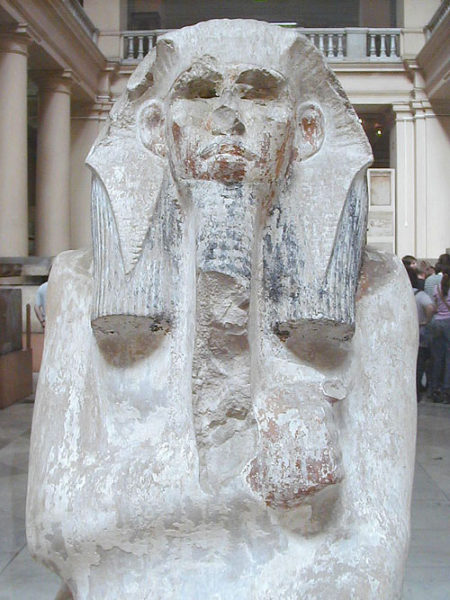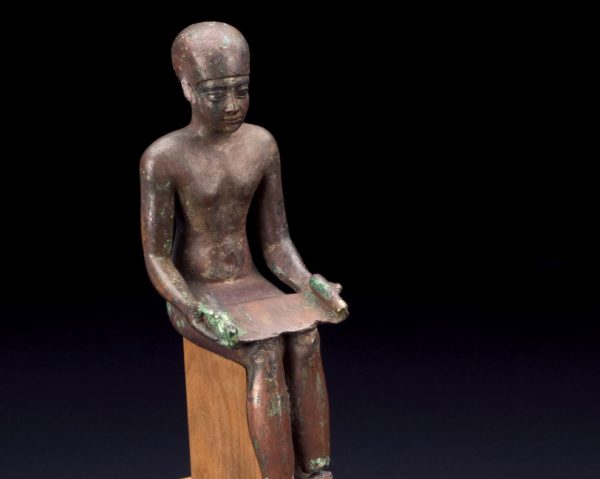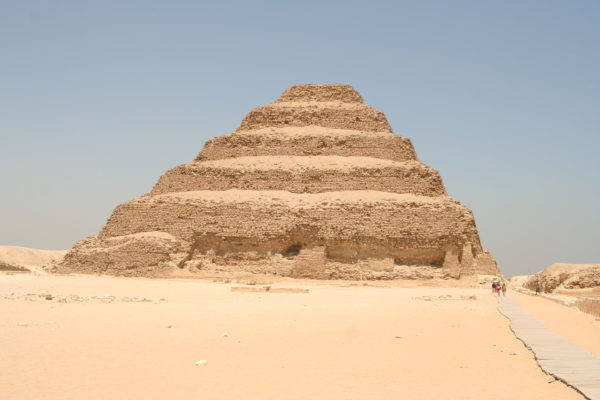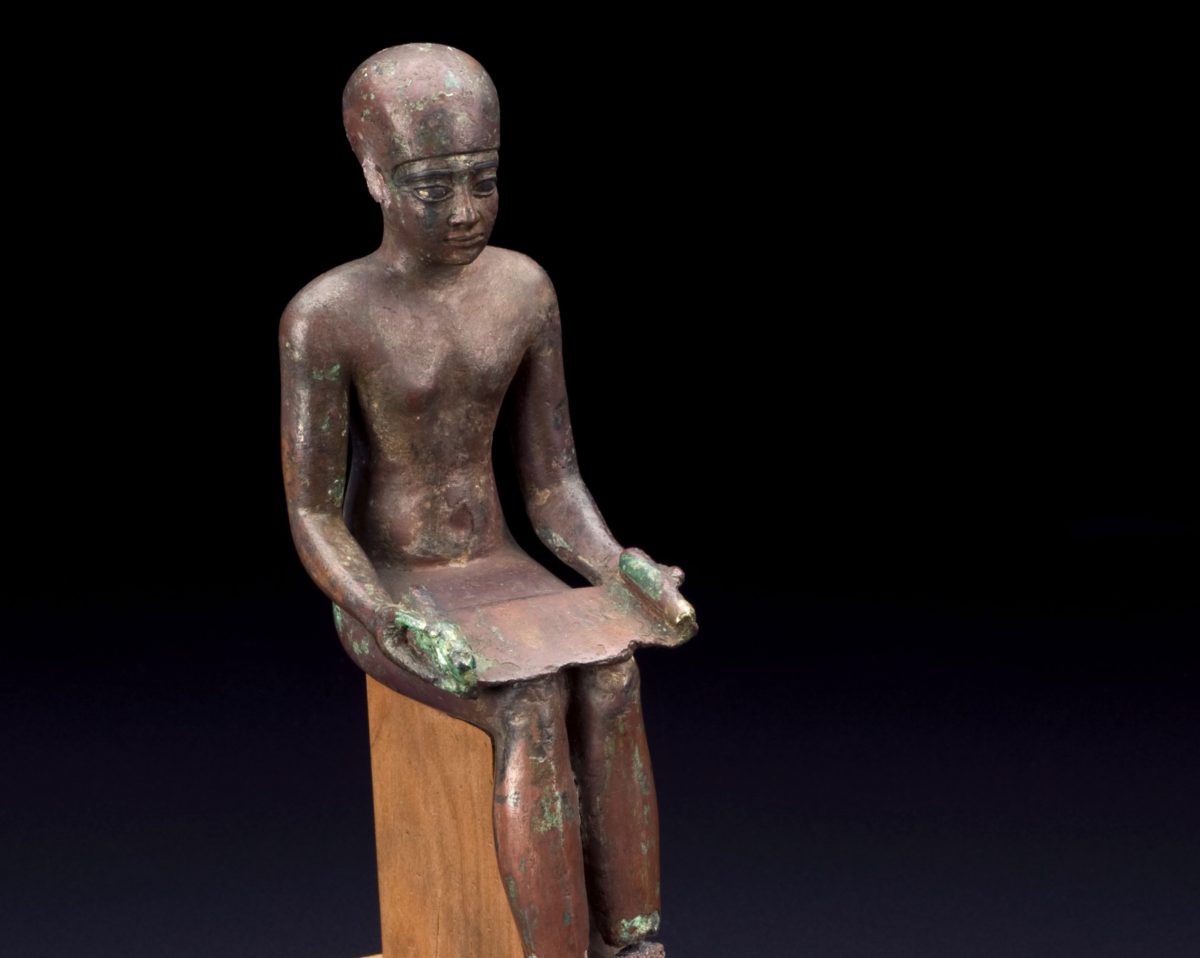Who was Imhotep?
Imhotep lived over 4600 years ago and was the highest official in Egypt during the rule of King Netjerkhet (also known as Djoser). This King ruled Kemet from around 2686 BCE and was the first ruler of what we now call ‘Dynasty 3’. Imhotep was also said to be the architect of the King’s burial monument, which was in the form of a stepped pyramid. This was the world’s first monumental stone building and was situated at the site we now call Saqqara in northern Egypt/Kemet.

This particular statue of the King shows the dark brown pigment used to represent his skin and also the bulk of his African-type hair, over which he wears a headdress.
Imhotep the god

Credit: Science Museum, London. Wellcome Images
Imhotep was deified over 2000 years after his death. For a mortal to become a god was highly unusual in ancient Kemet. Kings were divine on account of their office and so were different to non-royal people. Most images of Imhotep as a god date to the Late period, around 600-30 BCE. He is shown wearing a cap and holding a papyrus role, on which the ancient Kemites wrote. It was the Greeks who identified Imhotep with their god of medicine and so many years after his death he took on this additional role.
Most of the small copper alloy figures that represent Imhotep were dedicated at sanctuaries by visitors. Imhotep was worshiped at the Ptolemaic period temple below, which is at the much earlier site of Deir el Medina, or the workman’s village. This was where the tomb builders on the West Bank of Thebes lived and were buried. The photo below shows the house foundations (right) and the mud-brick temple (centre-left).

In addition to Imhotep another, later, architect Amenhotep son of Hapu was also worshipped at the site, along with the two main deities Hathor and Maat.
A Late cult centre at Saqqara

Another cult centre developed at Saqqara, where Imhotep had designed his famous pyramid. Here, visitors would dedicate animal mummies in the form of an Ibis bird in honour of Imhotep the god. It has long been assumed that Imhotep himself was buried somewhere at Saqqara because of his position and status. His tomb has never been found in spite of archaeologists working all over this extensive site.
Imhotep the Kemite
I often hear Imhotep referred to as a ‘Nubian’, he was in fact a Kemite who lived in the northern region of the country. I have written before about the importance of acknowledging Kemet and its people as indigenous Africans. His achievement in designing and overseeing the construction of a monument such as the step pyramid is impressive and is testimony to the advanced skills of the people of Kemet.


Why are the ancient people of the land called Egypt refered to as Egyptians when Egyptians did not exist .why are they not refered to as ancient kemetians or something along that line.. maybe it’s fair to call the Greeks that invaded the land during that time ancient Egyptians but people that previously built that land were not Egyptians. Just my view
Yes it’s a good point. When I worked on a virtual version of the Fitzwilliam Museum’s galleries anything pre-Ptolemaic was described as Kemite for this reason. It’s helps to dismiss some of the preconceptions regarding ‘Ancient Egypt’ and its population. There are other ways that we can support this approach- by using the ancient names as they were written rather than the Hellenised versions.
Hi Sally, I love your site. I have a question. The Famine Stela of Dojser states”…Shrines covered with dust, Everyone was in distress….I consulted one of the staff of the Ibis, the Chief lector-priest of Imhotep, son of Ptah South-of-the-Wall….He departed, he returned to me quickly, He let me know the flow of Hapy…”
M. Lichtheim, Ancient Egyptian Literature, vol.3, The University of California Press 1980, pp.95f.
In Piye’s Stela(25th Dynasty) when he is calling for Memphis to Surrender it says ” His majesty sailed north to] Memphis; then he sent to them, saying: “Shut not up, fight not, thou abode of Shu in the beginning. As for him that would go in, let him go in; as for him that would come out, let him come out; and let not them that would leave be hindered. I would offer an oblation to Ptah and to the gods dwelling in Memphis, I would sacrifice to Sokar in the mysterious place, I would behold ‘Him-Who-is-South-of-His-Wall,’ that I may sail north in peace. [The people] of Memphis [shall be] safe and sound; not even a child shall weep. Look ye to nomes of the South; not a single one has been slain therein, except the enemies who blasphemed against the god, who were dispatched as rebels.”
-James Henry Breasted, Ancient Records of Egypt. (Chicago: 1906), Part IV §§ 816 ff
I love this part of Piye’s Stela as it stirs the same passion that Shakespeare’s Henry V’s scene when he is at the walls of Calais.
Getting back to my question is the phrase “South of the Wall” the term that Egyptians and Nubian’s referred to Nubia (Interchangeably) ?
Secondly, I agree with you Imhotep is an Egyptian. To Parapharse Herodotus ” If you Drink water whose source is the Nile from its mouth of the Nile to Elephantine you are Egyptian. However, do you think it is incorrect to infer that his father came from Nubia as the Famine Stela says “Imhotep, son of Ptah South-of-the-Wall…” ?
Thanks so very much for your time and for taking away some of the curtain that is Egyptology.
When the 25th Dynasty were in Kemet, as opposed to Kush, they adopted the traditional language of that country. To my knowledge the term is only used in Kemet. Thank you for the reference- many readers may not be aware of the stela, and as you say it is an interesting one.
Hello Sally my Name is Clinton and I just wanted to thank you so much for all the work you’ve done to expose Kemet as an African civilization It means a lot to me as a man of African descent to know that my history is more than slavery and servitude
Thank you Clinton. I will be writing up responses for some of the Black History classes I ran last year. I looked at the impact of a number of different themes on the groups I was teaching, including Kemet and compared it with the history of enslavement. The results were interesting and as you point out it is so important to have a more balanced view of African history.
Cheik Anta Diop’s groundbreaking work “The African Origin of Civilization: Myth or Reality” and other works from African scholars in connection to “KMT” remain highly sidelined even today.
The foundation and development of certain key elements of Egyptology as a discipline raises questions about the cultural bias inherent in scientific research.
It is good to see new scholars shine new light but learning, referencing and acknowledgement of true pioneers is vital to the genuine continuity and understanding of this ancient and great African culture and society.
Thank you so much for answering my question, I really appreciate it. It seems like in the modern day, most scholar’s are getting away from the super race of invader’s bringing in civilization from sumer hypothesis and realizing that Ancient Egypt was of African origin by African people. Are there any scholar’s now writing any new material (that you know of) for the African origin of Egypt and what were your thoughts on the book Black Genesis by Robert Bauval & Thomas Brophy? Because to me it seems like scholars are becoming more interested in the Ancient Sudan and it’s many cultures. Like they’re more respectful towards ancient Nubia than ever before. Is that how you see it or do you see it differently. I hope I’m not asking to many questions. It’s not every day, you get to talk to an expert on ancient kemet 🙂
It’s always great to have questions and when people share ideas. What concerns me about Black Genesis is that it can read as if the author implies that the Dynastic Kemites (for want of a better term- I mean those who we recognise as dynasties) were not indigenous African people. Culturally and in terms of their representations I see them also as African people in every sense of the descriptor.
As for scholarly interest in Sudan/Nubia, it increasingly seems to be Egyptologists who work in this region and their preference is often to look at material that relates to Kemite history and culture rather than the contemporary cultures of Kush. I know from the work I have done at the Nubian Museum in Aswan and the National Museum in Khartoum that my colleagues there quite rightly preference the ancient cultures from this region over Kemite history and culture. In more mainstream museums Kush is often neglected or just ‘attached’ to Kemet. It deserves its own space and story (in my opinion).
Hello! Can you tell me why Natba Playa is so over looked. I mean that was such a great prehistoric civilization and it seems like even from some egyptologist, they don’t care or even know about it. I hate to use race card here but the only reason why I see this great culture being ignored is because the people who built natba playa were black. I would love to hear your opinion on this matter
Hi Charles. That is a really good question so thank you for raising it. From a scholarly point of view Egyptology has traditionally preferenced the later periods and language. There are still relatively few Egyptologists who are specialists in material culture (objects). The Pre-Dynastic period and the Early Dynastic period, which includes the first two dynasties, are also often neglected even though we start to see writing in a basic form for the Early Dynastic kings. So, I feel there is evidence of a bias against the early non-literary cultures. Similarly the later periods remain unpopular for some reason. However, your point is also true of the ancient cultures in what is now Sudan (Kush), which are equally impressive and also linked to ancient Kemet. And here I believe we start to see a degree of racism creeping into the subject. Kemet has been viewed as Egypt for so long, and promoted as non-African in terms of its culture and people that it has become entrenched in European and North American contemporary culture and appropriated as such. As we know from looking at any history curriculum in these regions, there is a preference for European culture and presenting the past from a Eurocentric perspective. In this respect, preference is given to the cultures to the north. So, I don’t believe that you are using the ‘race card’ if we look at the development of Egyptology as a discipline there is strong evidence to suggest its foundations are inherently racist and that this still permeates through some of the literature and has an impact on more popular interest in the subject.